|
|
General Tom Thumb
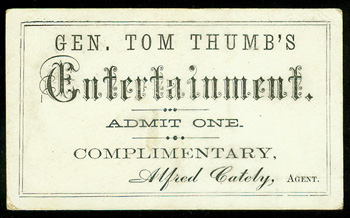
Admissiom Ticket for "Gen. Tom Thumb's Entertainment" inscribed Complimentary, Alfred Cately, Agent
Circa 1860
P. T. Barnum discovered the four-year-old Charles Sherwood Stratton in Bridgeport, Connecticut, in 1842.
Stratton, the tiny son of a carpenter who was hopelessly embarrassed by his offspring's stature,
was a mere 25 inches tall and weighed only 15 pounds. Barnum quickly realized the potential for
the doll-sized boy, and contracted with his father for a trial month in Barnum’s New York
museum, for which Barnum would pay $3 a week plus room, board, and travel expenses for the boy and his mother.
These were considered rather handsome wages at the time, so the elder Stratton overcame his misgivings and
consented to the arrangement.
In New York, Barnum transformed the four-year-old Charles Stratton from Connecticut into the
eleven-year-old General Tom Thumb, a prodigy freshly arrived from Europe. Barnum himself
undertook to train little Charles in courtly manners, the memorization of witty quips, and the
performance of several dances and dramatic roles. Attired in fanciful costumes, Tom would
imitate Hercules, a sailor, a Scottish highlander, or Napoleon, among others.
To say that Tom Thumb was a smash hit hardly describes the phenomenon he was to become. The
public simply devoured his antics, and paid Barnum and Sherwood handsomely for it. Thumb soon
embarked on an American tour, and in 1844 headed for Europe where he was commanded to appear
before Queen Victoria.
About 1856, following events which forced Barnum to declare bankruptcy, the then teenaged Stratton rallied round his mentor to
help him regain his financial footing. That year the team of Barnum and Thumb set forth once again for England, where Tom again
dazzled the royal family.
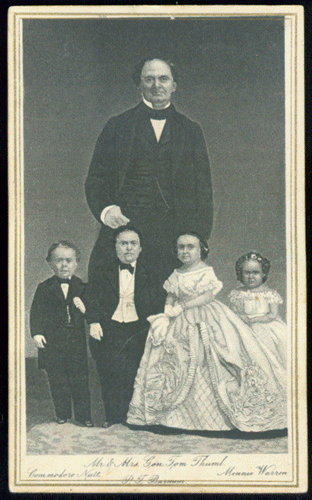
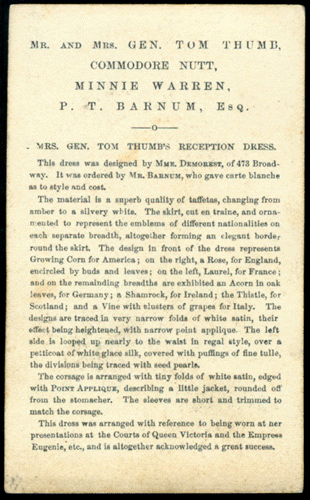
Mr. & Mrs. Gen. Tom Thumb, Commodore Nutt, Minnie Warren,
P. T. Barnum.
carte de visite, photo engraving
on card stock, 4 x 2.5 inches, 1863; text printed on reverse
This card is one in a seemingly endless stream of souvenirs relating
to the much ballyhooed ‘fairy wedding’ of Charles "Tom Thumb" Stratton
to Mercy Lavinia Warren Bump at New York's Grace Episcopal Church on 10
February 1863. P. T. Barnum footed the bill for the wedding, and generated
tremendous publicity (and revenue) in the weeks prior to and following the
nuptials. For several weeks before the wedding, Barnum displayed Lavinia’s
wedding gown in the front window of a store on Fifth Avenue.
Enormous crowds filled the streets outside the church, while the pews
inside were filled with fellow performers and society notables. Commodore
Nutt and Lavinia’s shorter and younger sister Minnie acted as attendants.
The Thumbs afterwards honeymooned in Philadelphia, Baltimore and Washington.
In Washington they were invited by President Lincoln to be the guests
of honor at a special White House reception.
A description of Lavinia’s ‘reception dress’ appears on this card
as follows:
MR. AND MRS. GEN. TOM THUMB,
COMMODORE NUTT,
MINNIE WARREN,
P. T. BARNUM, ESQ.
—o—
MRS. GEN. TOM THUMB’S RECEPTION DRESS.
This dress was designed by Mme. Demorest, of 473 Broadway. It was
ordered by Mr. Barnum, who gave carte blanche as to style and cost.
The material is a superb quality of taffetas, changing from amber
to a silvery white. The skirt, cut en traine, and ornamented to represent
the emblems of different nationalities on each separate breadth, altogether
forming an elegant border round the skirt. The design in front of the dress
represents Growing Corn for America; on the right, a Rose, for England,
encircled by buds and leaves; on the left, Laurel, for France; and on the
remainding [sic] breadths are exhibited an Acorn in oak leaves, for Germany;
a Shamrock, for Ireland; the Thistle, for Scotland; and a Vine with clusters
of grapes for Italy. The designs are traced in very narrow folds of white
satin, their effect being heightened, with narrow point appliqué.
The left side is looped up nearly to the waist in regal style, over a
petticoat of white glace silk, covered with puffings of fine tulle, the
divisions being traced with seed pearls.
The corsage is arranged with tiny folds of white satin, edged with
POINT APPLIQUE, describing a little jacket, rounded off from the stomacher.
The sleeves are short and trimmed to match the corsage.
This dress was arranged with reference to being worn at her presentations
at the Courts of Queen Victoria and the Empress Eugenie, etc., and is
altogether acknowledged a great success.
 Minnie Warren and Commodore Nutt
Minnie Warren and Commodore Nutt
carte de visite, 4 x 2.5 inches, circa 1863; partial remains of a U.S. Internal
Revenue 2-cent stamp on reverse
photographer: unknown
Barnum attempted to create another publicity coup by pretending there was a budding romance
between Commodore Nutt, Tom Thumb’s rival and successor, and Mrs. Thumb’s younger sister, Minnie Warren.
The romance was pure fantasy. Though the couple worked together for many years, no actual romantic alliance ever developed. Minnie did later marry
another Barnum little person, Major Edward Newell.
The other man in this photograph — who may have been included for no other reason than
to indicate scale — may be Sylvester Bleeker, who served as Barnum’s most
trusted agent. Bleeker traveled with the Thumb entourage as manager in
the years following the Fairy Wedding.
Commodore Nutt appears in my tribute to P.T. Barnum, The Showman and
His Museum, which may be seem
here.
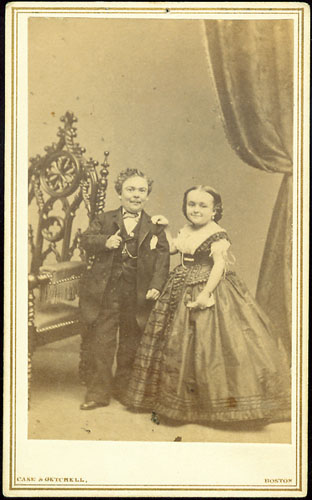 Tom Thumb and Wife
Tom Thumb and Wife
carte de visite, 4 x 2.5 inches,
circa 1863; signed in pencil on reverse "Tom Thumb & Wife"
photographer: Case & Getchell, Photographic Artists, 299 1/2 Washington St., Boston
 Tom Thumb, Wife and Child
Tom Thumb, Wife and Child
carte de visite, 4 x 2.5 inches, circa 1865
photographer: unknown
Once the thrill of the honeymoon died down, the next natural sensation would have been for Tom and
Lavinia to have a child. Much to Barnum's chagrin, the couple didn't seem to be making much
progress on that front. Not one to be daunted by factual circumstance, Barnum 'acquired' a baby
from a local orphanage and claimed the foundling was the natural heir to the Thumb name. This
increased public interest in the Thumbs, so Tom and Lavinia happily played along. However, after a
few years the baby grew larger than his 'parents', which both Barnum and the Thumbs agreed was bad
for business. It was decided that a child of Tom Thumb — natural or impersonated — should not grow, so
thereafter Barnum would find a new baby to fill in wherever they traveled, a system Lavinia explained simply:
“English babies in England, French babies in France, and German babies in Germany.”
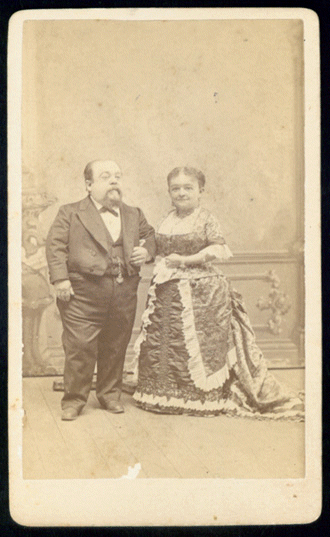 General and Mrs. Tom Thumb
General and Mrs. Tom Thumb
carte de visite, 4 x 2.5 inches,
circa 1881 or 1882; signed in pencil on reverse “Mr. & Mrs. Tom Thumb”
photographer: unknown
This photo of General and Mrs. Tom Thumb was taken when the pair was
in their early forties.
In 1881, the famous couple rejoined Barnum under the banner of the
Barnum and London Circus for what was advertised as their final season
of exhibition. The previous few years had been difficult for Tom and Lavinia,
especially following the death of Lavinia’s sister Minnie in 1878, who died painfully while
giving birth to a full-sized child. The couple was deeply depressed by this tragedy,
and Barnum himself had to intervene and encourage them to remain active.
Later, on tour in Milwaukee in January 1883, the Thumbs nearly perished when a fire broke out
in their hotel. They were saved by their manager Sylvester Bleeker, but Bleeker’s wife
died after trying to escape the fire by jumping from a high window. Tom never fully recovered
from the emotional trauma of this incident.
On 15 July 1883, while Lavinia was off on tour, Tom died of a sudden stroke in their home in
Middleborough, Massachusetts. Tom Thumb was 46 years old. Ten thousand people attended his funeral.
Lavinia remarried two years later and toured with her new husband, Count Primo Magri, but continued to be billed as Mrs. Tom Thumb. Lavinia died at the age of 77 on 25 November 1919. She was buried beside Tom.
|

|

|

|
All Images and Text © James G. Mundie 2003 - 2020
|



